|

|
Looking at our little HIVE community after quite some months of existence I think it's doing rather well. Some really excellent photographers like for example @akukamaruzzaman, @digitalis or @brianhphotos are enjoying the visitor with their brilliant macros, @borjan is writing impressive articles about his long walks and expeditions, and I really appreciate the support of @faltermann, a butterfly expert and dedicated insect lover. Thank you and all these other engaged members which are contributing to the success of "Fascinating Insects"!
Also the recent community support by @acidyo with @ocdb is highly appreciated!
Of course where there is light, there is also shadow. For example plagiarism is always a threat as the internet offers lots of opportunities for cheaters to find and use content which isn't their own.
Another problem is that many users are too careless when it comes to the names or any details about the insects in their pictures. Way too often bugs are called beetles, wasps named flies or spiders labelled as insects.
My advice: if you don't know the exact name of an insect in your pictures neither guess nor invent one - better just ask. :)
In my eyes one of the aims of this community, apart from offering fantastic photos, is to spread knowledge about our little creatures and educate the reader. Furthermore, the impression the community makes on people outside HIVE matters, so please, be careful with your statements. :)
It's my daily (and really time consuming) job to go through the big amount of new posts and spot and correct at least the biggest mistakes.
To ease this work a little bit, recently I started to create some text blocks to explain typical errors and misunderstandings.
Today I would like to publish some of these boilerplates and pin this post as kind of (extensible) 'knowledge box' for our members on top of the community.
So here we go:
What's the difference between spiders and insects?
Spiders with eight legs and a bipartite body (prosoma, opisthosoma), belong to the order Araneae and the class Arachnida, while insects with six legs and a tripartite body (Caput, Thorax, Abdomen), belong to the class Insecta.
Both belong to the phylum Arthropoda.
'Woodlouse spider' (Dysdera crocata).

'Red-headed cardinal beetle' (Pyrochroa serraticornis), as example for an insect.
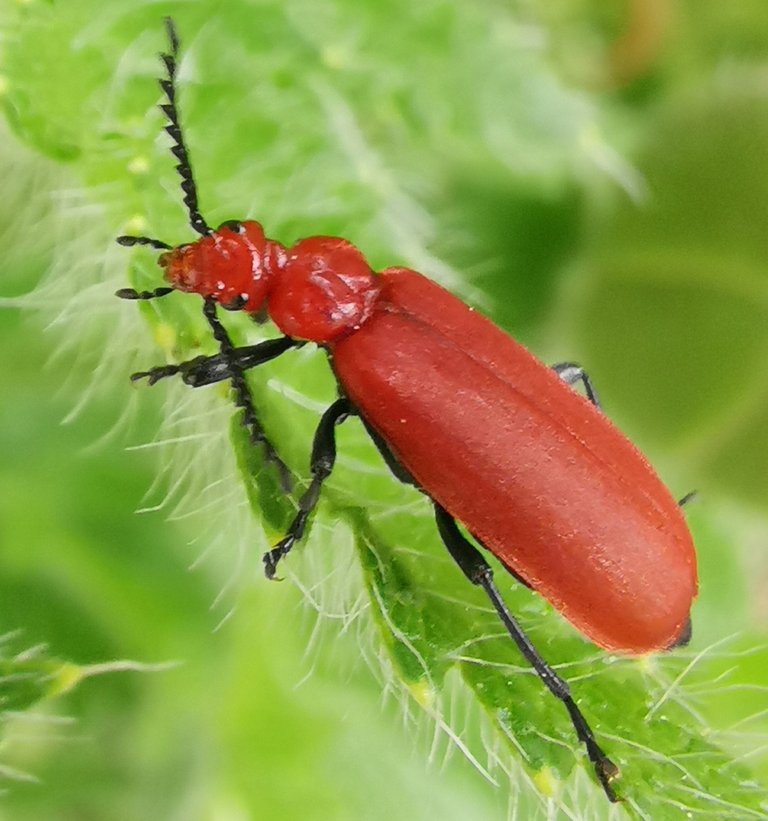
What's the difference between bugs and beetles?
Bugs (suborder Heteroptera) are having hemelytra where only the basal half is thickened while the apex is membranous (a part of the elytra looks somewhat transparent).
The other main difference between bugs and beetles (order Coleoptera) is that beetles have chewing mouth parts where their mandibles play an important role, while bugs are using a multipiece proboscis for stinging and sucking plant sap or the haemolymph of their victims.
'Red-legged shieldbug' (Pentatoma rufipes).
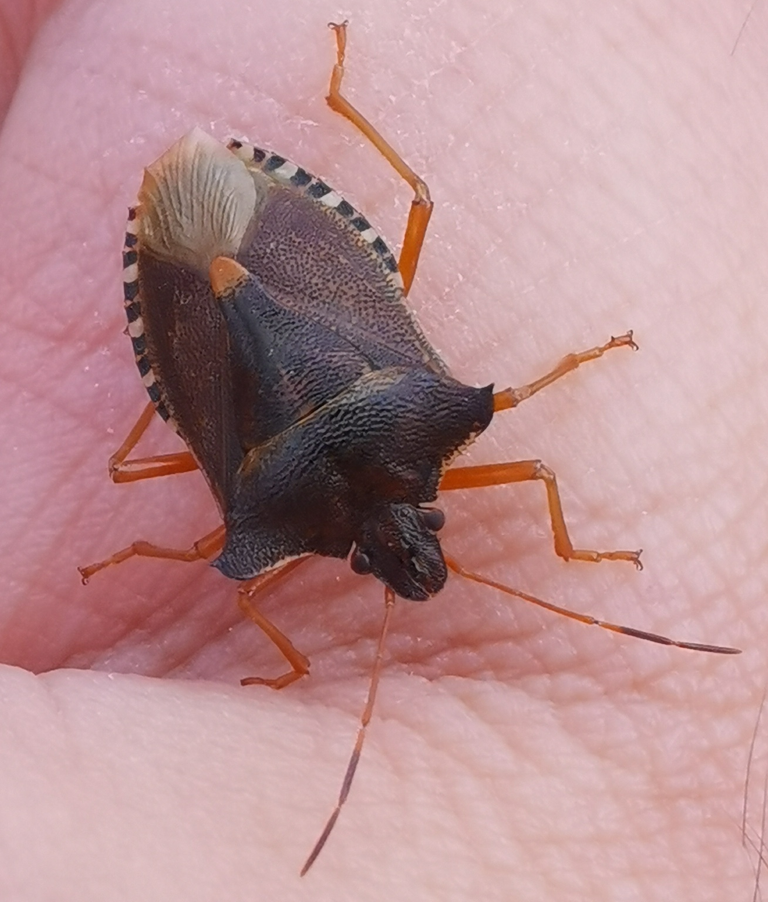
The 'Maybug' (Melolontha melolontha) is a beetle!
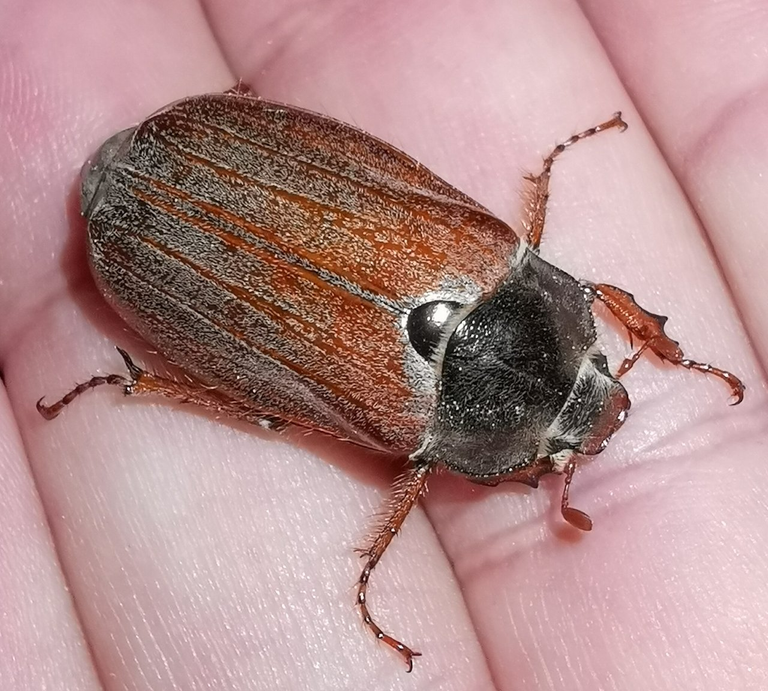
What's the difference between flies and bees, wasps, ants?
Bees (like for example also wasps and ants) belong to the order Hymenoptera.
However, flies belong to the order Diptera which - unlike alate Hymenoptera - have only two wings plus halteres.
Furthermore, if experienced enough, you may recognize the typical eye shape and colour, mouthparts (proboscis) and short antennae of many fly species.
Flies of the genus Lucilia.
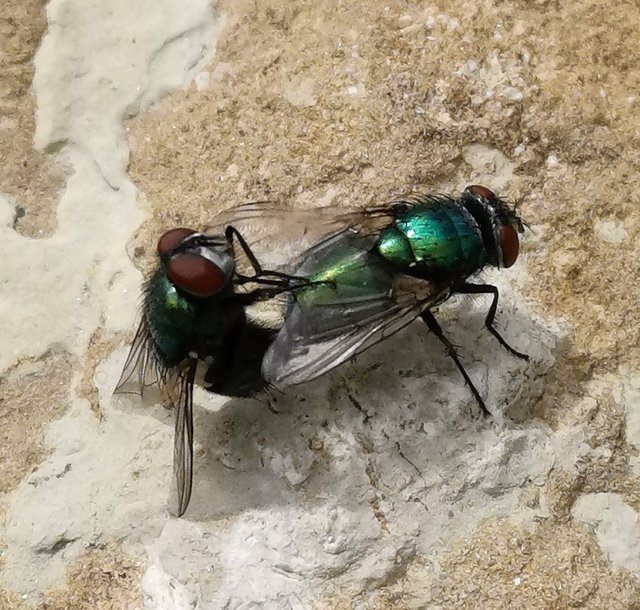
'European orchard bee' (Osmia cornuta) as example for a Hymenoptera species.

How to differentiate bees from other wasp species?
Bees (Anthophila) use a proboscis to incorporate nectar. All bees are vegetarians.
Other wasp species possess chewing-biting mandibles to be able to crush their prey, for example insects and spiders. Many of them are omnivorous.
The body of bees is usually rounder and more hairy, while other wasps are more elongated, slender, with a clearly visible waist, and less hairy.
The colors of bees are usually rather dark (brown, gray, ...).
Other wasps often show a black yellow (sometimes reddish) warning color.
'Western honey bee' (Apis mellifera).
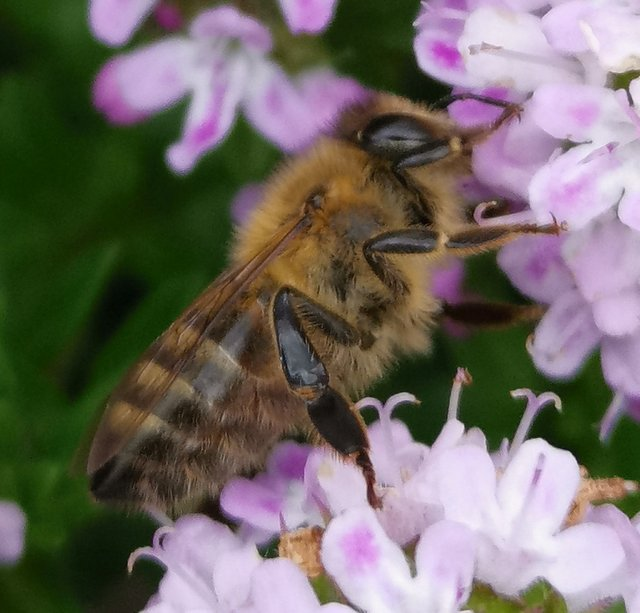
'Cuckoo wasp' Hedychrum nobile.
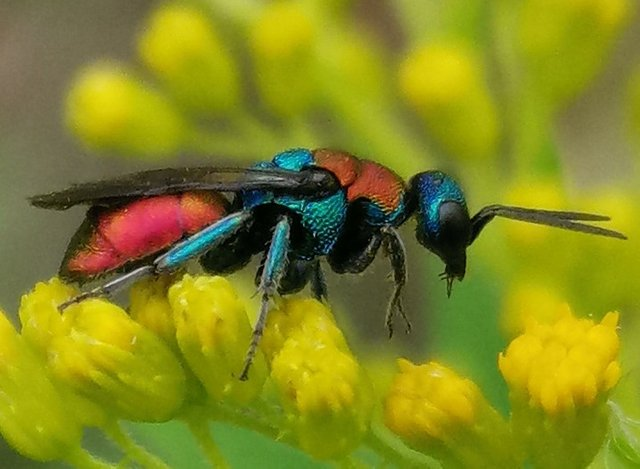
Don't confuse hoverflies with bees and wasps!
(Harmless) 'hoverflies' (family Syrphidae, order Diptera) are mimicking venomous insects (for example wasps and bees, order Hymenoptera).
Like all other flies they have only two wings plus halteres, while wasps and bees have four wings.
The concept behind this Batesian mimicry is to be protected by appearing like a dangerous insect but at the same time saving the energy which would be necessary to produce venom.
Helophilus pendulus as example for a hoverfly.

'European paper wasp' (Polistes dominula).
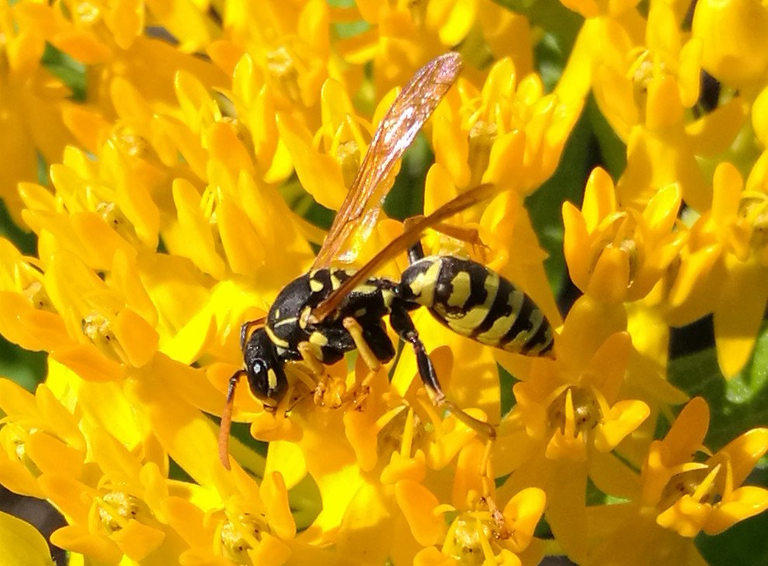
How to differentiate between grasshoppers and crickets?
The order Orthoptera is divided in the suborders Caelifera (including grasshoppers and locusts) with short antennae and Ensifera (including crickets) with long antennae.
Orthoptera species of the suborder Caelifera.
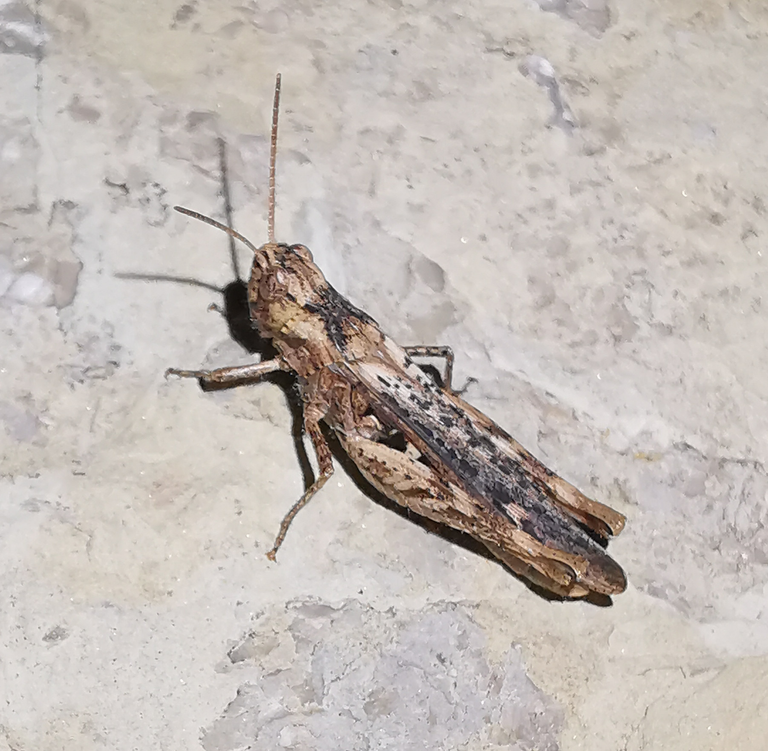
Nymph of the 'great green bush-cricket' (Tettigonia viridissima) as representative for the suborder Ensifera.

Dragonfly or damselfly?
The order Odonata is subdivided in dragonflies (suborder Epiprocta, infraorder Anisoptera) and damselflies (suborder Zygoptera).
Dragonflies are usually larger, their eyes border on each other, their wings are held open, horizontally or downwards at rest, and their wing pairs are dissimilar, with hind wings broader at the base.
Damselflies are usually smaller, their eyes are clearly separated from each other, their wings are held closed, usually over the abdomen at rest, and all wings are similar in shape.
Aeshna cyanea ('southern hawker'), Dragonfly.
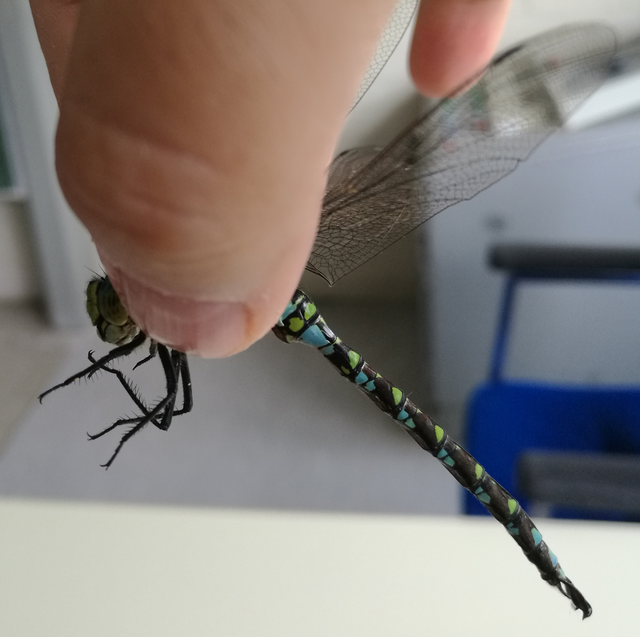
'Blue-tailed damselfly' (Ischnura elegans). Many thanks @faltermann for providing this beautiful photo!
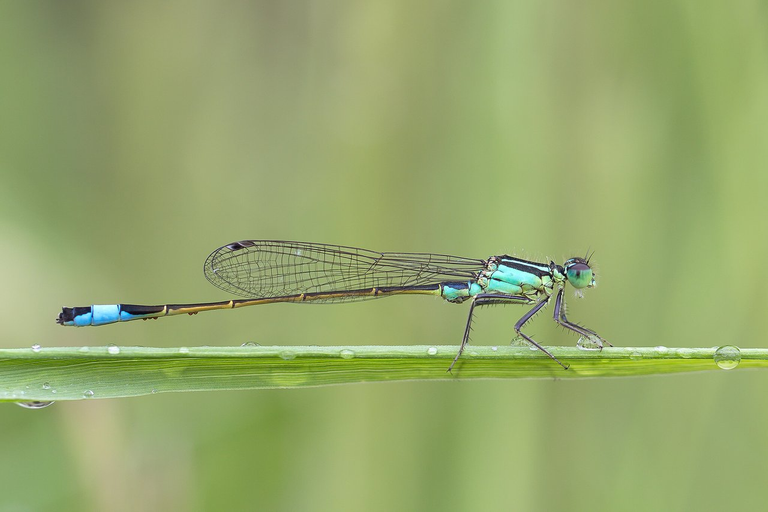
How many legs do caterpillars have?
Like all other insects also caterpillars have only six legs (three pairs near the head). Structures of the abdomen which appear to be additional legs are called prolegs.
| Caterpillar of the 'Old World swallowtail' (Papilio machaon), photo stolen from my wife, @kobold-djawa. :) |
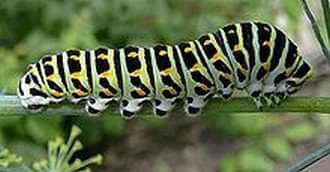
|
What are the differences between harvestmen and spiders?
Both taxa belong to the class Arachnida, however, spiders have a bipartite body (with prosoma and opisthosoma), while in harvestmen (order Opiliones) the connection between prosoma and opisthosoma is so broad that the body appears to be one single oval structure.
Furthermore, harvestmen have no silk glands and therefore don't build webs.
'Harvestman' (order Opiliones).
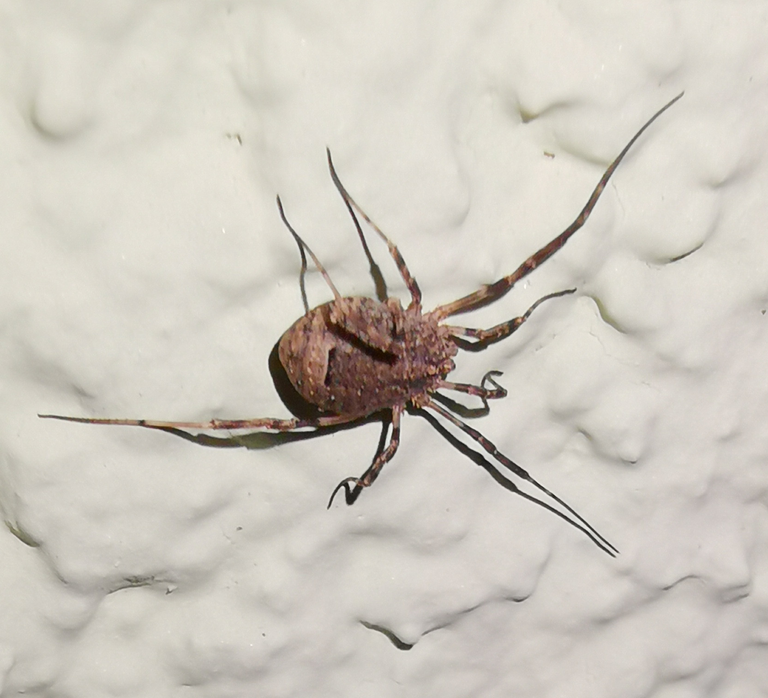
'Crab spider' (family Thomisidae).

Final remark.
Many people fear insects, call them a "pest", "annoying" etc. and even try to kill them.
However, there is a reason why I chose the name "Fascinating Insects" for this community.
Let me mention some amazing facts about my beloved little creatures:
-
Some insects simply look fantastic, especially under the microscope: shining like gold with huge eyes in many colors, bizarre structures, frightening mandibles, colorful patterned wings ...
-
Body plan of insects is extremly flexible and adaptable: they have populated nearly all habitats which earth has to offer, they are able to run quickly, to fly, to swim, to climb, to grub and to jump.
-
Insects can attack and defend themselves in many different ways: they bite with sharp mandibles, produce poison and sting their victims, use raptorial forelegs (like for example the members of the order Mantodea), put out evil-smelling secretions or even 'explode' (bombardier beetles, Brachininae and others)![1]
-
Their diffusion based tracheal breathing[2] limits the maximal reachable size of the insects but on the other hand it is an extremely efficient respiratory system which makes it possible to 'inject' the advecting oxygen partly directly into the cells. That is the reason why for example ants can transport things which weigh a multiple of their own weight.
-
Some insects build highly developed, complex states where different castes (in case of ants and termites we have for example a queen, drones, workers and soldiers) have to fulfill very specialized tasks. Leafcutter ants even raise fungi in their nests which they "feed" with collected leaves.[3]
-
As a whole state (where the single ants, wasps or bees could be compared with the neurons of a brain) but also as single individuals insects can act surprisingly intelligent.[4], [5], [6], [7], [8]
Always when I hear someone call insects a "pest" I ask "Why? Do they pollute their environment, destroy the rain forests, change the climate, overfish the oceans, produce plastic and radioactive waste, conduct wars? Or is Homo sapiens doing all that? So who is the pest?" :)
Insects are doing exactly the same as every other organism on this planet (including us), too: to forage, try to defend themselves, find sexual partners to spread their genes into the next generation. Because of their huge success in doing all that we tend to consider some insect species as serious concurrents.
This is a community from insect lovers for insect lovers where the fascinating little creatures aren't "pests" but the main actors, the glamorous, admired stars! :-)
Sources:
- http://www.pnas.org/content/96/17/9705.full
- http://www.biology-pages.info/T/Tracheal_Breathing.html
- http://www.reed.edu/biology/professors/srenn/pages/teaching/web_2010/ec_ant_site_FINAL/index.html
- https://www.researchgate.net/publication/267509261_Soziale_Insekten_kollektive_Intelligenz_eines_Superorganismus
- http://www.spiegel.de/wissenschaft/natur/bei-der-futtersuche-denken-hummeln-logisch-a-892749.html
- http://www.cell.com/current-biology/abstract/S0960-9822(13)00337-0
- https://hive.blog/science/@jaki01/intelligence-of-insects-part-i
- https://hive.blog/science/@jaki01/intelligence-of-insects-part-ii
Zeitlos guter Beitrag. Wieder so ein Beitrag, bei dem ich denke, daß man da immer drauf voten können sollte / müsste. Zudem ist der Beitrag für den Biologie Unterricht am Gymmie geeignet. Und auch für den Englisch Unterricht... ;-)
Haha, vielen Dank für dein großes Lob, aber jetzt bitte nicht übertreiben! :-)
Bio Unterricht geht klar. Das war ja zu erwarten. Damit Du das in Erinnerung behältst, was ich sage, muß ich ja noch einen drauflegen... ;-) ;-)
A great contribution and also a lesson in biology. This article is also an enrichment for me, because I have not yet dealt in detail with the difference between bugs and beetles. The arrangement of the wings and especially the development of the two species could not be bigger. In any case, your contribution is an enrichment for me and at the same time a stimulus to take a closer look.
For your article I would like to help out with a damsflye (Ischnura elegans).

Thanks, that's great! The picture will be integrated into my article immediately! :)
Thank you for sharing this. Its good to know all of that😍..
Nice to hear that the post was of use for you. :)
Awesome post! Very educational but also enjoyable. I learned a lot of new things here. I am really glad to see your insect community growing so fast. To be honest, at the beginning, I was wondering if this "niche" is not too small and marginal to make it big here on Hive but boy was I wrong! You have been such an amazing insect ambassador @jaki01 :) You have my utmost respect for your work, just like all the regular contributors whose spectacular insect photos I always enjoy... Great job guys!
This is a fantastic post, great effort @jaki01!
I do see a lot of incorrect ID's on this community. Like you say it doesn't take much to at least find the right group an insect belongs to, although this post should go a long way to helping with the basic ID's.
If people don't know what they have, then I'd rather they didn't just guess randomly. All that does is spread the mis-information further. There is also no shame in asking for help with ID's, no one knows everything... in fact with so many insects species across the globe I can guarantee no one knows everything, the field of study is simply too vast.
This is spot on. I still can't work why someone thinks posting "horrid little bugs that I killed" is acceptable here...
The fact remains that if Humans disappeared overnight then Life would still go on. If ALL mammals disappeared then Life would still go on. However if all Insects (and related invertebrates) disappeared this world would fall apart.
haha, the ideas are floating in the air!
I started writing a post about problems of mushroom identifying (CREATED JUST A SCHEME OF DOING CORRECT FOTOS SO FAR). I am sure this is what was needed! resteemed to examine carefully later.
!ENGAGE 50 - and cheers!
What a beautiful and useful post!
I have always feared all kind of insects, until the quarantine. Then, I started taking long walks near my home and I discovered many fascinating insects which I photographed :) So, I have a tremendous admiration & respect towards them now.
May I ask if I could possibly ask you for help in identifying a couple of insects I have come across?
Thank you in advance :))
(I saved this little fellow yesterday, because my two cats were playing with him)
Sure, if time allows! Just start posting here. :)
You know, most of the time it isn't difficult to determine the order or also family of an insect, but to find out the exact species (especially when only pictures are available) can be very time consuming, and sometimes it's even impossible.
Well-done friend you are very wright about what you have said one need to be sure and know the different @jaki01
I think the confusion around the word bug is a specific problem among English speaking people. While the word "bug" is legit term for a whole family of insects, its also used commonly for basically all - and mainly unwanted - insects in general.
In German for example we don't have that problem really. The german word for "bug" (real bugs) is "Wanze", while beetles are "Käfer". It's not common to call all insects "Wanze" here.
And I think that the lax common usage of the word "bug" is the result of the fact that the big majority of people neither know nor care about the differences between various insect taxa - and if they are the same anyway, it doesn't matter whether to call them bugs, beetles or whatever.
It may be right that many English speaking people are using the word "bug" for all insects, but neverthelss, you will always find "beetle" connected with the scientific term "Coleoptera" and "bug" with "Heteroptera" in specialist books.
Apart from that, whenever possible I prefer the usage of the scientific names (here: "Coleoptera" and "Heteroptera") of the various taxa because they are more accurate and unambiguous. However, when writing here I have to make some compromises so that every reader can understand what I mean.
Finally, my painful experience (in general but also every single day here in "Fascinating Insects") tells me that confusing bugs with beetles is far from being a linguistic problem only. Most people simply don't know the differences between the various insect taxa, which means that an article like this one is really urgently needed.
thats totally my case. I didnt cared (well, as a non native speaker, sometimes I simply do not see difference in semantics). but i will happily educate myself. THX!
Sure a valid point, but the thing is, that in English the word bug has this two ways of being used. Also in Germany there are a lot of people who have no clue about the different insects. May be they know a house fly and a wasp and a spider. But they won't call everything else Wanze, or Käfer. They might say Viecher (critters) or something like that.
Then just let's say that calling everything a "bug" is the elegant way of English native speakers to 'solve' the problem not to know anything about insects (don't take that interpretation too serious). :)
Anyway, thanks for pointing out that phenomenon.
haha, elegant' - indeed. like one can use word 'gonna' and gave up and add any grammatical constructions he'd like to, afterwards
:P
lol
Bookmarked! I made so many mistakes with determining insects that I really need such a guide. Thanks a lot!
You are welcome! :)
@spaminator bugging?
Lol, I just noticed it.
Probably because I used parts of some old posts (I cannot make 20 new example pics for the different insect orders, as I wrote, I was creating some 'text blocks', which can be used to correct typical mistakes, and I already wrote before why I like insects).
Anyway, a big part of the text is new, and the parts taken from my older (own!) posts make complete sense in this context.
If that is what @spaminator marks, I can't take all this serious anymore.
Relying too much on automation is not great, especially if they let that blacklist without manual oversight and approval.
Honestly if these projects can't do a proper job at the lows they don't deserve the rewards at the highs.
One problem is that they just don't talk, so one can only guess what their motives are.
I just noticed that also @icuz is marked.
@icuz is the brother of my wife (@kobold-djawa). He is still living in Indonesia and we try to guide him how to use HIVE properly and support him when he is writing here. That's why I grant him some high upvotes from time to time. His English is not the best (however, compared to my Indonesian language skills it's great) but he always only posts his own original content, and tries his best to do things well. So again I have not the slightest idea what the problem could be.
I also use his Splinterlands account to trade cards as so far he doesn't (and can't) play himself.
Maybe @guiltyparties can help, not really sure who handles @spaminator.
Right, maybe, but for now I am just fed up.
I don't like the attitude to shoot first before talking/asking what the matter is and then let the 'victim' beg to take back the measures again.
I know for 100 % that I didn't do anything wrong, and that matters for me.
If @guiltyparties or anybody else from the 'gang' wants to contact me, of course I won't decline to talk to them. :)
It's no fun, but I just try to continue, especially as I started that HIVE Soccer Cup, which will last the whole Bundesliga season.
Thanks a lot for your help/concern!
Check your transactions, your posting key may be compromised. There are two reasons someone ends up on Spaminator: 1. spam/farming 2. hacked warning
I'll follow up on Discord after we know for sure.
I'm from Indonesia, I really feel that my feeling @jaki01 has Indonesian blood and so on. :)
Lol ...
Great and informative post, my friend @jaki01, but since I know almost nothing about insects, I try to at least take good photos with them, the ideal is still far away, but I'm just learning, do not judge strictly)
I'm a bit of a stickler for trying to label things properly, but I'm no expert on invertabrates. This is particularly well timed for me, because I've also been trying to identify some of them for the Stock Images invertabrates sub index, while keeping in mind what people will generally look for if not an entomologist. This is really informative, so I've featured your post in the @HomeEdders weekly curation.
Curated by @minismallholding on behalf of @HomeEdders.
Supporting home education and educational content. If you're a home educator, home educated or are thinking about home education, find out what we're about HERE.
You can join the community by clicking the subscribe button on Hive or Peakd.
please feel free to join us on discord.
Awesome info. Now I know the difference. Tnx
I am happy to read that you can benefit from this post! :)
Greetings @jak01 thank you for this great contribution you give us especially to those who are not experts in the field that like you love or fascinate this world. I will be attentive to those details mentioned so as not to fall into mistakes and make them recurrent. Grateful with your community and all your general contribution including the collaborators.
Friend your post is great we are all actually running after the light not looking at the shadows,Friend, your guideline is very beautiful because we are just leaning towards competition, we are not looking down, there is nothing around us, but we are not paying any attention to it. Your guideline may be very useful to us.
Excellent guide for those of us who dare to write in this community because we like insects but we are not specialists. Very didactic. Thank you very much for sharing it. Greetings
Hi Friends @jaki01
Your writing will help writers a lot to identify bugs, beetles, insects, spiders, bees, wasps, mosquitoes, flies and small animals in a general way. If we try to understand. Otherwise, not.
I hope that such an advisory post will help users improve their writing and post quality.
@mrnazrul
If I scale 0 to 10 of my knowledge about insects,I thought it was 5 or 6. But after reading this post, seems like my knowledge on insect is a big zero!
I am not a insect lover and can't remember when I was last fascinated by seeing an insect (except childhood's running behind the butterfly 🦋). But I really enjoyed your post which differentiates between two similar creatures.
@jaki01 - I am not really a big fan of insects. But from your post help me to understand more and at least know how to classify it accordingly. Thanks for sharing. :-)
Congratulations, @andyjim You Successfully Trended The Post Shared By @jaki01.
You Utilized 2/3 Daily Summon Bot Calls.
TAN Current Market Price : 0.200 HIVE
Very good, this is very extraordinary, I admit and I often mention the wrong attack name. now there are examples and names of insects so that people don't name them wrong. Therefore the pictures they get are so good it depends on the capture tool. they use canon cameras and so on. some people use smartphone cameras so the image clarity is clearly different. ;)
Wooow
Liked that post? :)
ENGAGEtokens.Many thanks for this posts, bookmarked it!
I will take care and have a look to it next time I will shot insects.
There are so many different families and species, that it is a little bit difficult for newbies. But i'm still confused with bees and hoverflies.
I am happy to know that this post is of use for you!
If you check your pictures you will notice that hoverflies (like all flies) have only two wings (bees and wasps have four).
Then, furthermore, I think one can recognize kind of a 'white spot' on the back/side of the flies in some of your pictures. These reduced wings are called "halteres". Please check this image.
The eyes of hoverflies are huge, their antennae very short, and their proboscis looks different than the one of bees.
I will put the same comment also under your post.
I'm new here, and I found a friend sharing his post here, I'm interested in small animals like insects, I'll share it as soon as I post this comment.
!tan
Congratulations, @goldcoin You Successfully Trended The Post Shared By @jaki01.
You Utilized 2/3 Daily Summon Bot Calls.
TAN Current Market Price : 0.100 HIVE
!tangent
Congratulations, @asimo You Successfully Trended The Post Shared By @jaki01.
You Utilized 3/3 Daily Summon Bot Calls.
TAN Current Market Price : 0.200 HIVE
Are you inventing something!
Congratulations @jaki01, You Earned 4.134 TAN & Curators Made 4.134 TAN.
Join CORE / VAULT Token Discord Channel or Join UPMELINK Web Site
TAN Current Market Price : 0.200 HIVE
I had a good lesson in zoology but did not delve into details of the class Insecta as this. Very refreshing and educating. It will come handier when identifying the insect becomes essential but the majority of the users in the community are laymen who just enjoy the thrills of the little creatures.
It is a nice insect which is nice and I also really like it. I hope I can always see the content that you share about various kinds of very good and unique insects. thank you for sharing which is very good
Oops. I just published with a picture of a large earthworm. Looks like that might not be an insect at all ... maybe. Let me know if I got it wrong.
Earworms (order Dermaptera) are insects.
Greetings, your information is very valuable and quite useful for me, since I have started macrophotography for a few months, thanks for sharing.
I know it's late but I just read now that you liked this post - nice to hear that. :)
This is a really fascinating community where I'd love to explore all the fascinating insects.
Thank you so much for educating us on the difference between various insects and also the difference between pest and pet in insects.
I didn't see your comment earlier. Nice if you could learn something from my post! :)
Wow, it's been a while though but I'm so glad you stopped by.
Yes it will be 😊.